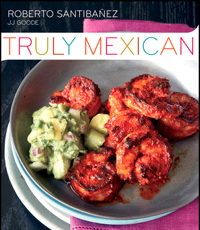Missed Cinco de Mayo?
Mexican food works all year round: no need to limit yourself as long as you arm yourself with a good cookbook such as Roberto Santibanez‘s Truly Mexican (Wiley 2011) with JJ Goode and Shelley Wiseman. The premise is that Mexican cuisine, much like French, Italian or Chinese cuisine, can be mastered if you learn how to make sauces.
Once you’ve roasted or toasted your ingredients, you’re almost always just a whir of the blender, and sometimes a simmer away from truly amazing Mexican food. That’s why this book begins with the fundamentals, where I walk you through the Mexican way to prepare ingredients, the easy techniques that create the flavors we’ve all come to think of as Mexican. (p. vii)
Roberto admits that there are sauces and dishes, like tamales, that are not included in this book – but approaching Mexican food as Escoffier approached French food (he attended the Cordon Bleu in Paris), he limited himself to the basic sauces (and the recipes you can make from them) in order to make Mexican home cooking extremely accessible.
 Roberto’s approach starts with the details on ingredients in the first chapter, Basics. Chiles get several tables and photographs by Romulo Yanes that show fresh and roasted chiles. There is plenty that might be unfamiliar, such as Hoja Santa (p.8) a green leaf herb or Xoconostle, a kind of prickly pears (p. 31).
Roberto’s approach starts with the details on ingredients in the first chapter, Basics. Chiles get several tables and photographs by Romulo Yanes that show fresh and roasted chiles. There is plenty that might be unfamiliar, such as Hoja Santa (p.8) a green leaf herb or Xoconostle, a kind of prickly pears (p. 31).
Roberto then tackles Salsas, starting off with “3 Keys to Great Salas”:
1. Salt is an essential.
2. You can make salsas in advance
3. Condiments salsas always taste better at room temperature. (p. 45)
He starts off with raw tomato salsas like Pico de Gallo (p. 46) and Fresh Yellow Tomato Salsa (p. 49) then tomatillo salsas, and other raw salsas, before moving on to cooked salsas like Roasted Cherry Tomato Salsa (p. 63) as well as more complicated ones. Once you’ve mastered Salsas, move on to Guacamoles, Adobos, and Moles & Popianes. The moles will take you around Mexico – Green Mole from Oaxaca (pp. 156-157), Yellow Mole from Queretaro (p. 163), Guanajuato-Style Green Mole (pp. 170-171), and Mole from Puebla (pp. 172-173).
Roberto’s strategy of focusing on sauces works, as long as understand where they fit into recipes for dishes. For that, check his last chapter – where even tamales get a recipe (p. 227) – and you can use any of the mole or adobo sauces with them.
Recipe: Basic Guajillo Adobo
3 ounces guajillo chiles (12), wiped clean, stemmed, slit open, seeded, and deveined
3/4 cup water for blending, if necessary
2 galic cloves, peeled
1 1/2 teaspoons apple-cider vinegar
3/4 teaspoons fine salt or 1 1/2 teaspoons kosher salt
3/4 teaspoon sugar
Rounded 1/4 teaspoon ground cuminHeat a comal, griddle, or heavy skillet over medium low heat, and toast the chiles 2 or 3 at a time, turning them over and pressing down on them with tongs frequently, until they’re fragrant and their insides have changed color slightly, about 1 minute per batch. Soak the chiles in enough cold water to cover until they’re soft, about 30 minutes. Drain and discard the water.
Put the 3/4 cup fresh water in the blender jar with the chiles and the remaining ingredients. Blend until smooth, at least 3 minutes, adding a little more water if necessary to puree. If you’d like a silky texture, strain the adobo through a medium-mesh sieve.
Now you can use this highly flavored puree as a marinade for seafood and meat. (page 130) Or turn it into a fabulous cooking liquid (page 136) or sauce for eggs, beans, and enchiladas (page 147).
The adobo keeps in the refrigerator for up to five days or in the freezer for up to one month.
